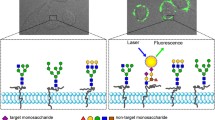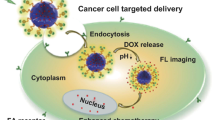Abstract
A carbon dots-embedded epitope imprinted polymer (C-MIP) was fabricated for targeted fluorescence imaging of cervical cancer by specifically recognizing the epidermal growth factor receptor (EGFR). The core-shell C-MIP was prepared by a reverse microemulsion polymerization method. This method used silica nanoparticles embedded with carbon dots as carriers, acrylamide as the main functional monomer, and N-terminal nonapeptides of EGFR modified by palmitic acid as templates. A series of characterizations (transmission electron microscope, dynamic light scattering, X-ray photoelectron spectroscopy, Fourier transform infrared spectroscopy, zeta potential, and energy dispersive X-ray spectroscopy) prove the successful synthesis of C-MIP. The fluorescence of C-MIP is quenched by the epitopes of EGFR due to the specific recognition of epitopes of EGFR through their imprinted cavities (analytical excitation/emission wavelengths, 540 nm/610 nm). The linear range of fluorescence quenching is 2.0 to 15.0 μg mL−1 and the determination limit is 0.73 μg mL−1. The targeted imaging capabilities of C-MIP are demonstrated through in vitro and in vivo experiments. The laser confocal imaging results indicate that HeLa cells (over-expression EGFR) incubated with C-MIP show stronger fluorescence than that of MCF-7 cells (low-expression EGFR), revealing that C-MIP can target tumor cells overexpressing EGFR. The results of imaging experiments in tumor-bearing mice exhibit that C-MIP has a better imaging effect than C-NIP, which further proves the targeted imaging ability of C-MIP in vivo.

An oriented epitope imprinted polymer embedded with carbon dots was prepared for the determination of the epitopes of epidermal growth factor receptor and targeted fluorescence imaging of cervical cancer.








Similar content being viewed by others
References
Jullien L, Gautier A (2015) Fluorogen-based reporters for fluorescence imaging: a review. Methods Appl Fluoresc 3:042007/1–042007/12. https://doi.org/10.1088/2050-6120/3/4/04200
Attia MF, Anton N, Wallyn J, Omran Z, Vandamme TF (2009) An overview of active and passive targeting strategies to improve the nanocarriers efficiency to tumour sites. J Pharm Pharmacol 71:1185–1198. https://doi.org/10.1111/jphp.13098
Zhang R, Fruhwirth GO, Coban O, Barrett JE, Burgoyne T, Lee SH, Simonson PD, Baday M, Kholodenko BN, Futter CE, Ng T, Selvin PR (2017) Probing the heterogeneity of protein kinase activation in cells by super-resolution microscopy. ACS Nano 11:249–257. https://doi.org/10.1021/acsnano.6b05356
Henson E, Chen Y, Gibson S (2017) EGFR family members’ regulation of autophagy is at a crossroads of cell survival and death in cancer. Cancers 9:27/1–27/13. https://doi.org/10.3390/cancers9040027
Zeng Y, Ren JQ, Guo SA, Hu JM (2018) Splicing nanoparticles-based “Click” SERS could aid multiplex liquid biopsy and accurate cellular imaging. J Am Chem Soc 140:10649–10652. https://doi.org/10.1021/jacs.8b04892
Ramanathan S, Gopinath SC, Arshad MM, Poopalan P, Anbu P (2019) A DNA based visual and colorimetric aggregation assay for the early growth factor receptor (EGFR) mutation by using unmodified gold nanoparticles. Microchim Acta 186:546. https://doi.org/10.1007/s00604-019-3696-y
Bodelón G, Montes-García V, Fernández-López C, Pastoriz-Santos I, Pérez-Juste J, M. Liz-Marzán L. (2016) Au@pNIPAM SERRS tags for multiplex immunophenotyping cellular receptors and imaging tumor cells. Small 11:4149–4157. https://doi.org/10.1002/smll.201500269
Zhang Y, Deng C, Liu S, Wu J, Chen Z, Li C, Lu W (2015) Active targeting of tumors through conformational epitope imprinting. Angew Chem Int Ed 54:5157–5160. https://doi.org/10.1002/anie.201412114
Zhang H (2019) Molecularly imprinted nanoparticles for biomedical applications. Adv Mater:e1806328. https://doi.org/10.1002/adma.201806328
Lee MH, Thomas JL, Chen YC, Chin WT, Lin HY (2013) The complete replacement of antibodies by protein-imprinted poly (ethylene-co-vinyl alcohol) in sandwich fluoroimmunoassays. Microchim Acta 180:1393–1399. https://doi.org/10.1007/s00604-013-0995-6
Zhou J, Wang Y, Bu J, Zhang B, Zhang Q (2019) Ni2+-BSA directional coordination-assisted magnetic molecularly imprinted microspheres with enhanced specific rebinding to target proteins. ACS Appl Mater Interfaces 11:25682–25690. https://doi.org/10.1021/acsami.9b06507
Rachkov A, Minoura N (2001) Towards molecularly imprinted polymers selective to peptides and proteins. The epitope approach. Biochim Biophys Acta 1544:255–266. https://doi.org/10.1016/S0167-4838(00)00226-0
Wang YZ, Li DY, He XW, Li WY, Zhang YK (2015) Epitope imprinted polymer nanoparticles containing fluorescent quantum dots for specific recognition of human serum albumin. Serum albumin. Microchim Acta 182:1465–1472. https://doi.org/10.1007/s00604-015-1464-1
Zhang G, Jiang L, Zhou J, Hu L, Feng S (2019) Epitope-imprinted mesoporous silica nanoparticles for specific recognition of tyrosine phosphorylation. Chem Commun 55:9927–9930. https://doi.org/10.1039/c9cc03950c
Zhang XM, Qin YP, Ye HL, Ma XT, He XW, Li WY, Zhang YK (2018) Silicon nanoparticles coated with an epitope-imprinted polymer for fluorometric determination of cytochrome c. Microchim Acta 185:173. https://doi.org/10.1007/s00604-018-2724-7
Zhang L, Chen L (2018) Visual detection of melamine by using a ratiometric fluorescent probe consisting of a red emitting CdTe core and a green emitting CdTe shell coated with a molecularly imprinted polymer. Microchim Acta 185:135. https://doi.org/10.1007/s00604-017-2664-7
Panagiotopoulou M, Kunath S, Medina-Rangel PX, Haupt K, Tse Sum Bui B (2017) Fluorescent molecularly imprinted polymers as plastic antibodies for selective labeling and imaging of hyaluronan and sialic acid on fixed and living cells. Biosens Bioelectron 88:85–93. https://doi.org/10.1016/j.bios.2016.07.080
Yang Q, Li J, Wang X, Xiong H, Chen L (2019) Ternary emission of a blue-, green-, and red-based molecular imprinting fluorescence sensor for the multiplexed and visual detection of bovine hemoglobin. Anal Chem 91:6561–6568. https://doi.org/10.1021/acs.analchem.9b00082
Xu J, Haupt K, Tse Sum Bui B (2010) Core-shell molecularly imprinted polymer nanoparticles as synthetic antibodies in a sandwich fluoroimmunoassay for trypsin determination in human serum. ACS Appl Mater Interfaces 9:24476–24483. https://doi.org/10.1021/acsami.7b05844
Sobiech M, Bujak P, Lulinski P, Ab P (2019) Semiconductor nanocrystal-polymer hybrid nanomaterials and their application in molecular imprinting. Nanoscale 11:12030–12074. https://doi.org/10.1039/c9nr02585e
Tian XT, Yin XB (2019) Carbon dots, unconventional preparation strategies, and applications beyond photoluminescence. Small:e1901803. https://doi.org/10.1002/smll.201901803
Du J, Xu N, Fan J, Sun W, Peng X (2019) Carbon dots for in vivo bioimaging and theranostics. Small 15:e1805087. https://doi.org/10.1002/smll.201805087
Demir B, Lemberger MM, Panagiotopoulou M, Medina Rangel PX, Timur S, Hirsch T, Tse Sum Bui B, Wegener J, Haupt K (2018) Tracking hyaluronan: molecularly imprinted polymer coated carbon dots for cancer cell targeting and imaging. ACS Appl Mater Interfaces 10:3305–3313. https://doi.org/10.1021/acsami.7b16225
Zhou X, Gao X, Liu M, Wang C, Chu F (2017) A poly(5-indolylboronic acid) based molecular imprint doped with carbon dots for fluorometric determination of glucose. Microchim Acta 184:4175–4181. https://doi.org/10.1007/s00604-017-2448-0
Zhu JY, Bai X, Chen X, Xie ZF, Zhu YS, Pan GC, Zhai Y, Zhang HZ, Dong B, Song HW (2018) Carbon dots with efficient solid-state red-light emission through the step-by-step surface modification towards light-emitting diodes. Dalton Trans 47:3811–3818. https://doi.org/10.1039/C7DT04579D
Song X, Li S, Guo H, You W, Shang X, Li R, Tu D, Zheng W, Chen Z, Yang H, Chen X (2019) Graphene oxide modified lanthanide nanoprobes for tumor-targeted visible/NIR-II luminescence imaging. Angew Chem Int Ed 52:18981–18986. https://doi.org/10.1002/ange.201909416
Dou YK, Chen Y, He XW, Li WY, Li YH, Zhang YK (2017) Synthesis of water-dispersible Mn2+ functionalized silicon nanoparticles under room temperature and atmospheric pressure for fluorescence and magnetic resonance dual-modality imaging. Anal Chem 21:11286–11292. https://doi.org/10.1021/acs.analchem.7b01644
Pisaneschi F, Slade RL, Iddon L, George GP, Nguyen QD, Spivey AC, Aboagye EO (2014) Synthesis of a new fluorine-18 glycosylated ‘click’ cyanoquinoline for the imaging of epidermal growth factor receptor. J Labelled Comp Radiopharm 57:92–96. https://doi.org/10.1002/jlcr.3170
Davidson NE, Gelmann EP, Lippman ME, Dickson RB (1987) Epidermal growth factor receptor gene expression in estrogen receptor-positive and negative human breast cancer cell lines. Mol Endocrinol 1:216–223. https://doi.org/10.1210/mend-1-3-216
Guo S, Wang YH, Miao L, Xu ZH, Lin CM, Zhang Y, Huang L (2013) Lipid-coated cisplatin nanoparticles induce neighboring effect and exhibit enhanced anticancer efficacy. ACS Nano 7:9896–9904. https://doi.org/10.1021/nn403606m
Dong Y, Li W, Gu Z, Xing R, Ma Y, Zhang Q, Liu Z (2019) Inhibition of HER2-positive breast cancer growth by blocking the HER2 signaling pathway with HER2-glycan-imprinted nanoparticles. Angew Chem Int Ed 58:10621–10625. https://doi.org/10.1002/ange.201904860
Yin D, Li X, Ma Y, Liu Z (2017) Targeted cancer imaging and photothermal therapy via monosaccharide-imprinted gold nanorods. Chem Commun 53:6716–6719. https://doi.org/10.1039/c7cc02247f
Gomez-Arribas LN, Urraca JL, Benito-Pena E, Moreno-Bondi MC (2019) Tag-specific affinity purification of recombinant proteins by using molecularly imprinted polymers. Anal Chem 91:4100–4106. https://doi.org/10.1021/ac8b05731
Li S, Yang K, Liu J, Jiang B, Zhang L, Zhang Y (2015) Surface-imprinted nanoparticles prepared with a his-tag-anchored epitope as the template. Anal Chem 87:4617–4620. https://doi.org/10.1021/ac5047246
Zhang F, Wang S, Yin L, Yang Y, Guan Y, Wang W, Xu H, Tao N (2015) Quantification of epidermal growth factor receptor eexpression level and binding kinetics on cell surfaces by surface plasmon resonance imaging. Anal Chem 87:9960–9965. https://doi.org/10.1021/ac5b02572
Funding
This work was financially supported by the National Natural Science Foundation of China (nos. 21775077 and 21475069) and the Tianjin Natural Science Foundation (no. 16JCZDJC37200).
Author information
Authors and Affiliations
Corresponding author
Ethics declarations
Conflict of interest
The authors declare that they have no competing interests.
Additional information
Publisher’s note
Springer Nature remains neutral with regard to jurisdictional claims in published maps and institutional affiliations.
Electronic supplementary material
ESM 1
(DOCX 4.23 mb)
Rights and permissions
About this article
Cite this article
Zhang, Y., Li, S., Ma, XT. et al. Carbon dots-embedded epitope imprinted polymer for targeted fluorescence imaging of cervical cancer via recognition of epidermal growth factor receptor. Microchim Acta 187, 228 (2020). https://doi.org/10.1007/s00604-020-4198-7
Received:
Accepted:
Published:
DOI: https://doi.org/10.1007/s00604-020-4198-7




